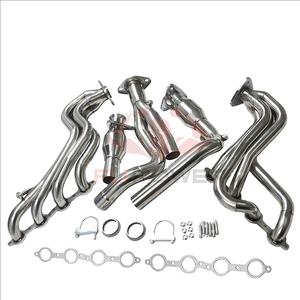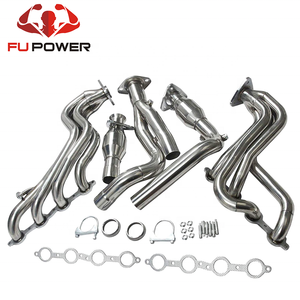(352 products available)





























































































































































































GMC headers are an essential part of exhaust systems in most trucks and vehicles. Their main role is to carry exhaust gases from the engine to the exhaust pipe. By replacing the factory-installed exhaust manifolds, headers are able to improve the performance of the engine, especially in large vehicles like trucks, by allowing exhaust gases to flow smoothly and quickly. This, in turn, helps to increase horsepower and torque in the vehicle. Several types of GMC headers are available, each designed to meet specific needs and requirements.
Long Tube Headers:
As the name suggests, long tube headers feature long primary tubes that extend far into the engine bay. These tubes collect exhaust gases from the engine's cylinders and channel them into a single pipe that leads to the exhaust system. The increased length of the primary tubes helps to improve the header's ability to scavenge exhaust gases. This ultimately results in better engine performance. Long tube headers are ideal for high-performance GMC models, such as the GMC Sierra Denali.
Shorty Headers:
Shorty headers have shorter primary tubes compared to long tube headers. Like long tube headers, shorty headers also replace the stock exhaust manifolds. They collect the exhaust gases and direct them into the exhaust pipes. The primary tubes in shorty headers are usually equal in length, and they measure between 12 to 16 inches. Shorty headers tend to be more affordable and easier to install than long tube headers. Because of this, shorty headers are a popular choice for many GMC models that have stock exhaust manifolds.
Tri-Y Headers:
Tri-Y headers are a combination of long tube and shorty headers. The primary tubes in Tri-Y headers merge into three Ys, which allows the headers to mimic the functionality of both long tube and shorty headers. This unique design helps to improve low-end torque and high-end horsepower. Tri-Y headers are suitable for heavy-duty GMC models, such as the GMC Sierra HD, that need more power and torque to pull loads.
1. Size and Compatibility
The headers are available in different sizes and are designed to suit specific GMC models. This includes the tube diameter and flange size. The tube diameter is usually between 1.5 inches and 2.5 inches. The size and compatibility of the GMC headers affect the performance and fitment on the vehicle.
2. Material
The headers are made of different materials which affects their performance and durability. The common material used in the headers is stainless steel, mild steel, and aluminized steel. Stainless steel headers are more durable and corrosion resistant.
3. Coating
The coatings on the headers increase the durability and performance of the headers. The headers have different coatings such as ceramic coated, chrome coated, and high heat coated. The coated headers are corrosion resistant and improve the appearance of the headers.
4. Type of Header
Different types of headers are suitable for different GMC models. The type of header determines the performance and the fitment of the header on the exhaust system. The common types of headers include shorty headers, long tube headers, and tri-Y headers.
5. Flange Thickness
The header flanges are mounted on the cylinder head and the exhaust system. The flanges are available in different thicknesses which affects their performance. The flange thickness ranges between 3/8 inches to 1 inch. Thick flanges reduce the vibration and improve the sound quality.
6. Port Shape and Size
The ports on the headers are connected to the cylinders. The shape and size of the ports affect the airflow and performance of the header. The ports are available in different shapes such as rectangular, oval, and circular designs. The ports are also available in different sizes to improve fitment on the cylinder head.
7. Collector Design
The collector on the headers merges the exhaust gases from the individual pipes and directs them to the exhaust system. The design of the collector affects the back pressure and performance of the header. The collectors are available in different designs such as merge collectors and ball socket collectors.
8. Gasket and Hardware Included
When purchasing a GMC header, the necessary hardware and gasket for installation are included. This includes bolts, nuts, washers, and flange gaskets. The gaskets and hardware are important for proper fitment of the headers and preventing exhaust leaks.
Proper maintenance of the headers is very important in order to increase their lifespan and improve their performance. Below are some of the maintenance tips for the GMC headers:
Before placing a bulk order of GMC truck exhaust headers, buyers should consider several factors to ensure they get the right headers for their intended market. They include:
Vehicle Compatibility
Selecting headers designed for a specific engine type and GMC model is essential. This ensures a precise fit and optimal performance. Buyers might need to provide the header supplier with the vehicle's make, model, and year to confirm compatibility.
Material
The material chosen for the headers has an impact on header durability and performance. Stainless steel headers are popular because of their resistance to rust and corrosion. They also have a long lifespan. On the other hand, mild steel headers are more affordable but less durable and prone to corrosion.
Design
Buyers should select headers with the right design for their market's intended use. For instance, long tube headers are ideal for those looking to maximize engine power. Conversely, shorty headers are suitable for buyers targeting users who prefer quicker engine warm-up times and a compact header design.
Coatings
Consider whether the headers have coatings that enhance durability and performance. Some headers have heat-resistant coatings that minimize heat damage and improve exhaust flow. Others have ceramic coatings that reduce engine bay heat and improve the headers' lifespan.
Flange Thickness
The header flanges should have the right thickness to enhance durability without adding unnecessary weight. A thicker flange also minimizes the chances of warping. Buyers should select flanged headers with a thickness that meets the needs of their market.
Ease of Installation
To make the headers more appealing to a wider market, buyers should select those that are easy to install. Furthermore, easy-to-install headers come with straightforward installation processes, allowing users to install them with basic tools or in a short time.
Budget
Buyers should select headers that offer value for money. They can compare different suppliers' offers to find headers that fit their budget while meeting their quality standards. Additionally, they should consider other expenses like shipping fees and customs duties.
GMC truck headers can be replaced as a DIY project. All the tools required are basic maintenance tools that truck owners have. The process is also straightforward. Before replacing the headers, it is important to know which type of header to install. Different headers exist for different GMC models, so choose the right one.
To replace the headers, first, remove the old ones. This will require a ratchet, 10mm deep socket, 15mm shallow socket, 13mm wrench, 14mm wrench, 18mm wrench, and 24mm wrench. Disconnect the negative battery cable using a 10 mm socket. Then, remove the air intake duct from the throttle body using a 7 mm socket and screw. After that, loosen the clamps on the exhaust pipes and pull them off the exhaust headers. Use a 15 mm deep socket to remove the header bolts on both sides of the engine. Then, remove the header bolts on the heat shield and remove the heat shield. Unbolt the air conditioner compressor from the exhaust pipe support and move it out of the way.
To remove the header on the driver’s side, disconnect the power steering tubes from the pumps and pull them off the tubes. Disconnect the EGR pipe and unbolt the EGR pipe support. Disconnect the EGR pipe and unbolt the EGR pipe support. Remove the spark plugs and unbolt the spark plug heat shield. Then, unbolt the fuel rail heat shield and move it out of the way. Disconnect the dipstick tube from the oil pan and remove it. The dipstick tube is connected to the oil pan using a 24 mm bolt. Unbolt the four 13 mm bolts that hold the dipstick tube to the support bracket on the valve cover. The dipstick tube will now be free to remove. The process of removing the driver’s side header is more complicated than the passenger’s side header.
On the passenger side, disconnect the starter motor's electrical connections and move the motor out of the way. Disconnect the vacuum lines from the brake booster and disconnect the air lines from the booster, then move them out of the way. Remove the spark plugs and unbolt the spark plug heat shield. Disconnect the EGR pipe from the engine.
Once all the bolts have been unfastened and the pipes disconnected, the old headers will come off easily. Clean the surface and place the new headers. Make sure the gaskets are in place to prevent leakages. Reverse the steps above to install the new headers.
Q1: Are GMC long tube headers worth it?
A1: Long tube headers are worth it. The long tubes on the headers allow exhaust gases to exit the engine quickly. This improves engine performance. The headers are ideal for those looking to improve their car's performance.
Q2: Can a GMC header fit on any truck?
A2: No, a header cannot fit on any truck. The header is designed to fit on a specific truck model. For example, the GMC sierra headers are designed to fit on Sierra trucks.
Q3: How do headers improve engine performance?
A3: Headers improve engine performance by making the engine breathe better. They reduce back pressure and allow exhaust gases to flow smoothly.